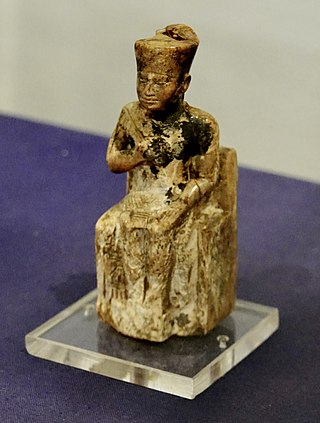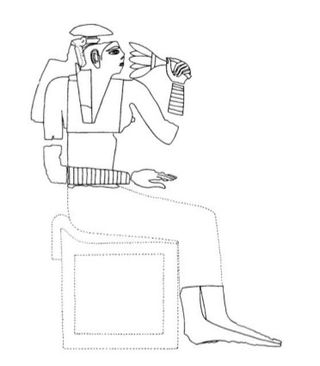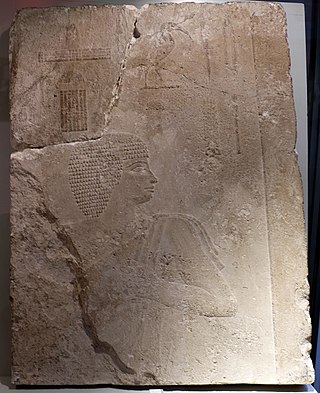| Duaenhor | |
|---|---|
| Prince of Egypt | |
 Plan of Duaenhor's tomb in Giza | |
| Burial | mastaba G 7550, Giza |
| Spouse | unknown woman |
| Issue | Nebtyhotep |
| Religion | Ancient Egyptian religion |
Duaenhor was a Prince of Egypt. He was named after god Horus.
| Duaenhor | |
|---|---|
| Prince of Egypt | |
 Plan of Duaenhor's tomb in Giza | |
| Burial | mastaba G 7550, Giza |
| Spouse | unknown woman |
| Issue | Nebtyhotep |
| Religion | Ancient Egyptian religion |
Duaenhor was a Prince of Egypt. He was named after god Horus.
Duaenhor is thought by some to be a son of Crown Prince Kawab and Queen Hetepheres II. If so, he would have been a grandson of Pharaoh Khufu and Queen Meritites I. [1] On the other hand, based on his titles, he may be one of the younger sons of Khufu (along with Khaemsekhem (G 7660), and Mindjedef (G 7760)). [2]
Duaenhor's brothers were Kaemsekhem and Mindjedef. [2] A daughter of Duaenhor was named Nebtyhotep. [3]
He held the titles King’s son of his body and Companion of his father. [4]
Duaenhor was buried at Giza in mastaba G 7550. In the tomb his father and mother are mentioned. His daughter is also mentioned on the south entrance facade. [3]
The scenes in the tomb show:

Khufu or Cheops was an ancient Egyptian monarch who was the second pharaoh of the Fourth Dynasty, in the first half of the Old Kingdom period. Khufu succeeded his father Sneferu as king. He is generally accepted as having commissioned the Great Pyramid of Giza, one of the Seven Wonders of the Ancient World, but many other aspects of his reign are poorly documented.

Menkaure, was an ancient Egyptian king (pharaoh) of the fourth dynasty during the Old Kingdom, who is well known under his Hellenized names Mykerinos and Menkheres. According to Manetho, he was the throne successor of king Bikheris, but according to archaeological evidence, he was almost certainly the successor of Khafre. Africanus reports as rulers of the fourth dynasty Sôris, Suphis I, Suphis II, Mencherês, Ratoisês, Bicheris, Sebercherês, and Thamphthis in this order. Menkaure became famous for his tomb, the Pyramid of Menkaure, at Giza and his statue triads, showing the king together with his wives Rekhetre and Khamerernebty and with various deities.

Hetepheres II was a Queen of Ancient Egypt during the 4th Dynasty.

The Fourth Dynasty of ancient Egypt is characterized as a "golden age" of the Old Kingdom of Egypt. Dynasty IV lasted from c. 2613 to 2494 BC. It was a time of peace and prosperity as well as one during which trade with other countries is documented.

Hetepheres I was a queen of Egypt during the Fourth Dynasty of Egypt who was a wife of one king, the mother of the next king, the grandmother of two more kings, and the figure who tied together two dynasties.

Ankhhaf was an Egyptian prince and served as an overseer during the reign of the Pharaoh Khufu, who is thought to have been Ankhhaf's half-brother. One of Ankhaf's titles is also as a vizier, but it is unknown which pharaoh he would have held this title under. He lived during Egypt's 4th Dynasty.

Queen Meresankh III was the daughter of Hetepheres II and Prince Kawab and a granddaughter of the Egyptian pharaoh Khufu. She was the wife of King Khafre.
Meritites I was an ancient Egyptian queen of the 4th Dynasty. Her name means "Beloved of her Father". Several of her titles are known from a stela found at Giza. She was buried in the middle Queen’s Pyramid in Giza.
Djedefhor or Hordjedef was a noble Egyptian of the 4th Dynasty. He was the son of Pharaoh Khufu and his name means "Enduring Like Horus".

Kawab is the name of an ancient Egyptian prince of the 4th Dynasty. He was the eldest son of King Khufu and Queen Meritites I. Kawab served as vizier and was buried in the double mastaba G 7110–7120 in the east field which is part of the Giza Necropolis.
Khufukhaf I was an ancient Egyptian prince and vizier of the 4th Dynasty.
Khamerernebty I was an ancient Egyptian queen of the 4th dynasty. She was probably a wife of King Khafre and the mother of King Menkaure and Queen Khamerernebty II. It is possible that she was a daughter of Khufu, based on the fact that inscriptions identify her as a King's daughter.
Nefermaat II was a member of the Egyptian royal family during the 4th Dynasty and vizier of Khafre.
Kaemsekhem was an ancient Egyptian nobleman and probably the son of Crown Prince Kawab and Hetepheres II. He later served as the director of the royal palace. He was buried in mastaba G 7660 in the Giza East Field, which is part of the Giza Necropolis.

Meresankh II was a Queen of Egypt who lived during 4th Dynasty.
Duaenre was a vizier under Menkaure during the Fourth Dynasty of Egypt. His titles include those of king's son of his body, hereditary prince, count, vizier (tAjtj), scribe of the divine book, mouth of Nekhen, and mouth of every Butite.

Meritites II or Meritites A was a 4th Dynasty princess of ancient Egypt, probably a daughter of King Khufu. She may have been a daughter of Meritites I based on the fact that this queen is mentioned in mastaba G 7650. She married the Director of the Palace, Akhethotep, and she had several children with her husband. Meritites and her husband shared a mastaba G 7650 in Giza.
Persenet was an ancient Egyptian queen consort of the 4th Dynasty. She may have been a daughter of King Khufu and a wife of King Khafre. She is mainly known from her tomb at Giza.
Nefertkau III was an ancient Egyptian princess. She lived during the 4th Dynasty. She was possibly a daughter of Meresankh II and Horbaef. If so, she was a granddaughter of King Khufu. Baud has proposed that Nefertkau was a daughter of Khufu instead. Nefertkau has the titles King's daughter of his body and Priestess of Neith in a scene in the chapel of her tomb. She was married to an official named Iynefer. Nefertkau and Iynefer had a daughter also called Nefertkau and two or three sons. Strudwick has suggested that Iynefer may be a son of Khufu. Depending on the interpretation of the family relationships Nefertkau may have married either her uncle or her brother.
Djaty I was a prince who lived in the ancient Egypt during the 4th Dynasty. He was an overseer of a royal expedition.